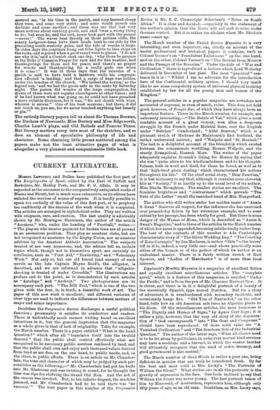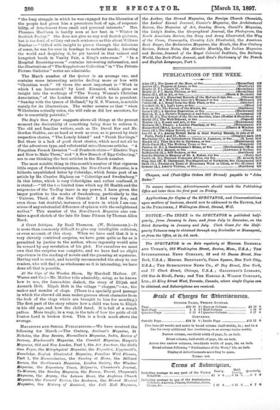CURRENT LITERATURE.
Messrs. Lawrence and Bullen have published the first part of The Encyclopedia of Sport, edited by the Earl of Suffolk and Berkshire, Mr. Hedley Peek, and Mr. F. G. Miele. It may be regarded as the successor to the comparatively antiquated works of Blaine and Strutt, but is much more exhaustive, as its editors have enlisted the services of scores of experts. It is hardly possible to speak too cordially of the value of this first part, or to prophesy too confidently of the success of the work when it is completed. The articles are arranged in alphabetical order. They are written with crispness, care, and caution. The last quality is admirably shown by Mr. Montague Shearman, the author of the article "Amateur," who, under the heading of "Football," writes :— " The players who receive payment for broken time are at present in an anomalous position. They play as amateur clubs, but are not recognised as amateurs by the Rugby Union, nor as amateur athletes by the Amateur Athletic Association." The subjects treated of are very numerous, and, the editors tell us, include topics which, though not in themselves sport, are certainly its corollaries, such as " First Aid," " Taxidermy," and " Veterinary Work." Not only so, but our old friend (and enemy) of such novels as the late Captain Mayne Reid's, the alligator, is described, and we are informed in advance that "alligator- shooting is treated of under Crocodile." The illustrations are profuse and to the point, as is demonstrated by such articles as "Antelope" and "Archery." Two photogravures are to accompany each part. "The Mill Pool," which is one of the two given with the first, is, in truth, a beautiful work of art. The paper of this new work is excellent; and different varieties of clear type are used to indicate the differences between matters of major and minor importance.
Doubtless the Progressive Review discharges a useful political function; presumably it satisfies its conductors and readers. There is undoubtedly much earnest writing based on excellent intentions in it; but the general impression that the magazine as a whole gives is that of lack of originality. Take, for example, the March number. There is a paper entitled " What is the Land Question ?" which after all "translates itself into the twofold demand " that the public shall control effectively what are recognised to be necessary public services rendered by land, and that the public shall own and enjoy such increased values derived from land as are due, on the one hand, to public needs, and, on the other, to public efforts. There is an article on Mr. Chamber- lain, the tone and character of which may be judged by such per- sonalities as the following,—" Mr. Chamberlain had put his knife into Mr. Gladstone and was twisting it round, for he thought the time was ripe for shelving the Grand Old Man. And the aid of the caucus was invoked. But, to his infinite disgust, the machine jammed, and Mr. Chamberlain had to be told there was `no vacancy." The best paper in this number of the Progressive Review is Mr. S. C. Cronwright Schreiner's "Notes on South Africa." It is clear and decided,—especially in the statement of the author's opinion that the Boers will not seek to come under German control. But it is rather too sibilant when Mr. Rhodes's name comes up.
The March number of the United Service Magazine is a very interesting, and even important, one, chiefly on account of the useful professional and historical papers it contains, such as Colonel Dooner's on "Fraudulent Enlistment" on the one hand, and on the other, Colonel Turner's on " The Retreat from Moscow and the Passage of the Beresina." Under the title of " War and Civilisation " there is reproduced a lecture which Lord Wolseley delivered in December of last year. The most "practical" sen- tence in it is : " Whilst I am no advocate for the introduction here of the Continental military system, I should very much like to see some compulsory system of universal physical training established by law for all the young men and women of the Kingdom."
The general articles in a popular magazine are nowadays not accounted of supreme, or even of much, value. This does not hold good, however, of Temple Bar, of which they have always been an important feature. Three in the March number, for example, are extremely interesting,—" The Battle of Val," which gives a most readable account of a great victory, won after a desperate struggle by the French under Marshal Saxe, over the English under " Butcher " Cumberland ; " Abb6 Scarron," which is a pleasant sketch of Madame de Maintenon's first husband, the rather underrated satirist ; and " Walpole and St. Hannah." The last is a delightful account of the friendship which existed between the consummate worldling, Horace Walpole, and the sturdy Evangelical, Hannah More. The writer of the paper adequately explains Hannah's liking for Horace by saying that she was " quite alive to his kindheartedness and to his thought- fulness, both in word and deed, for those he loved, as well as to that high-bred plain dealing' which characterised his actions throughout his life." Of the chief serial story, " Dear Faustina," it is but necessary to say that, although it contains some cleverish hits at " Society," it is hardly up to the usual level of its author, Miss Rhoda Broughton. The smaller stories are excellent. The feminine brightness and " contrariness " which pervade "The Fate of the Letter" recall the vanished band of Mrs. Hungerford.
The author who still writes under her maiden name of "Annie S. Swan" deserves all respect, for the influence she has exercised over present-day fiction by her strenuous example, and to some extent by her precept, has been wholly for good. But there is some danger of the Woman at Home, which is described as "Annie S. Swan's Magazine," and to three of the articles in the March number of which her name is appended, becoming intellectually rather limp. The best of the contents of this number is Ada Cambridge's characteristic story of " The Silver Wedding Day." "The Courting of Kate Carnegie," by Ian Maclaren, is rather "thin "—the lovers' tiff in it is, indeed, a very little one—and shows practically none either of the human or of the pathos of which its author is an undoubted master. There is a fairly written sketch of Earl Spencer, and "Ladies of Manchester" is of more than local interest.
Lippincott's Monthly Magazine is a magazine of excellent fiction and equally excellent miscellaneous articles. The "complete novel," which is a feature of this magazine, is entitled " Under the Pacific," and is from the pen of Mr. Clarence Herbert New. It is clever, and there is in it a delightful portrait of a beauty of the essentially Spanish type named Dorotea. But for a story of adventure it is overburdened with secondary incidents, and occasionally hangs fire. "Old Tom of Nantucket," on the other hand, tells how an old American salt lures an Algerine pirate to his doom. Of the miscellaneous articles, the most humorous is "The Dignity and Humor of Signs," by Agnes Carr Sage; it is rather a pity, however, that the very old story of the degenera- tion of " God encompasseth " into "The Goat and Compasses " should have been reproduced. Of more solid value are "A Vanished Civilisation " and " The Southern Side of the Industrial Question." The author of the latter says," What all classes need is to be let alone by politicians, in order that mutual kind services may have a seedtime and a harvest, in which the weaker brother will ultimately recognise that the need of order, decency, and good government is also mutual."
The March number of Good Words is rather a poor one, being deficient in articles that can truly be considered fresh. By far the best and most solid is Mrs. Lecky's " The Portraits of William the Silent." What strikes one in all the portraits is tho gravity of expression in the face. One feels inclined to say that William the Silent was never young. The last portrait taken of him by Miereveld, of Amsterdam, represents him, although only fifty years of age, as an old man. Doubtless, as Mrs. Lecky says, " the long struggle in which he was engaged for the liberation of the people had given him a premature look of age, of responsi-
bility, of detachment from small and personal interests." Mrs.
Florence MacCunn is hardly seen at her best in " Winter in Scottish Poetry." She does not give us any real Scotch pictures, but is too fond of rolling out such sentences as this about William Dunbar :—" Gifted with insight to pierce through the delusions of sense, he was for ever in bondage to material needs ; knowing the world and despising it, he yet tarried in that vainest and hungriest booth in Vanity Fair, a King's ante-room." "In a Hospital Receiving-room" contains interesting information, and the illustrations of " The Kepplestone Collection" in " The Private Picture Galleries " series are admirable.
The March number of the Quiver is an average one, and contains some interesting articles dealing more or less with
"Christian work." Of these the most important is "Work in which I am Interested," by Lord Kinnaird, which gives an insight into the workings of "The Young Women's Christian Association," of the London division of which he is president. " Sunday with the Queen of Holland," by M. S. Warren, is notable mainly for its illustrations. The writer assures us that " when Wilhelmina actually rules, she will rule as did her ancestors, for she is essentially patriotic."
The Boy's Own Paper suggests above all things at the present moment the desirability of something being done to enliven it.
The old and familiar writers, such as Mr. David Ker and Mr.
Gordon Stables, are as hard at work as ever, as is proved by their respective stories, "The Lonely Island" and "Frank Hardinge."
But there is a lack of good short stories, which need not all be of the adventure type, and substantial miscellaneous articles. "A Forgotten French Invasion "—of Pembrokeshire—" Electric Toys and How to Make Them," and "A New Branch of Egg-Collecting," are to our thinking the best articles in the March number.
The most notable thing in this month's number of that vigorous little organ of Swedenborgianism, the New-Church Magazine, is a
hitherto unpublished letter by Coleridge, which forms part of an article by Mr. Charles Higham on " Coleridge and Swedenborg." In this letter, which is very Coleridgian and rather confused, it is stated :—" Of the t JO limited time which my Ill Health and the
exigencies of the To-Day leave in my power, I have given the larger portion to the works of Swedenborg, particularly to the Univers. Theol. of the New Church.' I find very few, and even those but doubtful, instances of tenets in which I am con- scious of any substantial difference of opinion with the enlightened author." This number of the New-Church Magazine also con- tains a good sketch of the late Sir Isaac Pitman by Thomas Allen Reed.



































 Previous page
Previous page